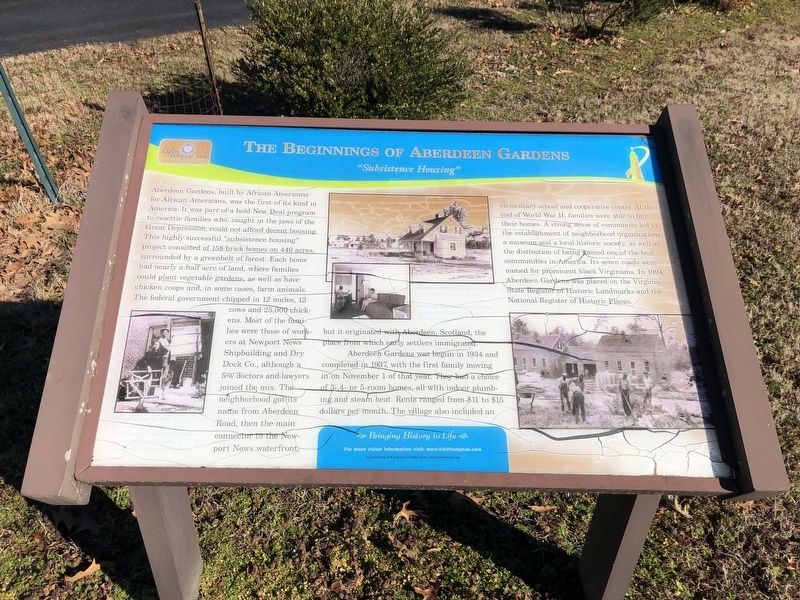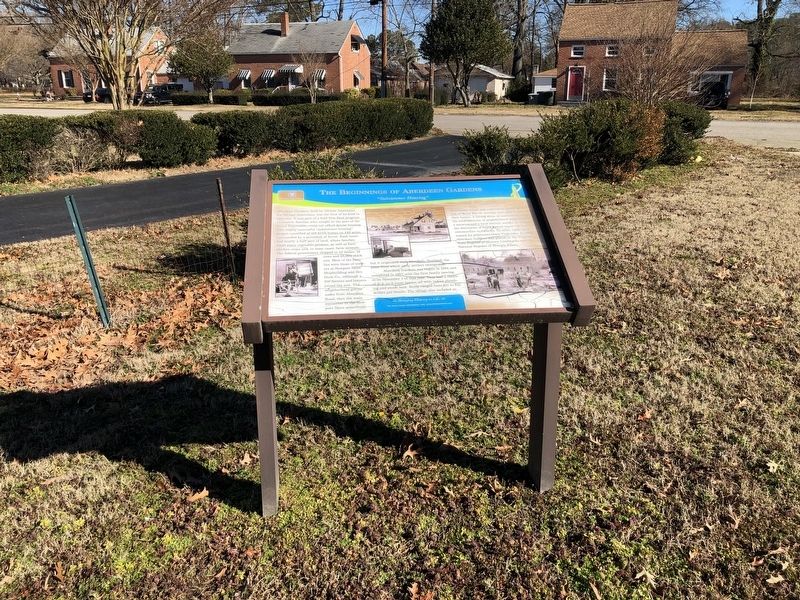Briarfield in Hampton, Virginia — The American South (Mid-Atlantic)
The Beginnings of Aberdeen Gardens
"Subsistence Housing"
— Explore Hampton 2010: From the Sea to the Stars —

Photographed By Devry Becker Jones (CC0), February 6, 2021
1. The Beginnings of Aberdeen Gardens Marker
Aberdeen Gardens, built by African Americans for African Americans, was the first of its kind in America. It was part of a bold New Deal program to resettle families who, caught in the jaws of the Great Depression, could not afford decent housing. This highly successful "subsistence housing" project consisted of 158 brick homes on 440 acres, surrounded by a greenbelt of forest. Each home had nearly a half acre of land, where families could plant vegetable gardens, as well as have chicken coops and, in some cases, farm animals. The federal government chipped in 12 mules, 12 cows and 25,000 chickens. Most of the families were those of workers at Newport News Shipbuilding and Dry Dock Co., although a few doctors and lawyers joined the mix. The neighborhood got its name from Aberdeen Road, then the main connector to the Newport News waterfront, but it originated with Aberdeen, Scotland, the place from which early settlers immigrated.
Aberdeen Gardens was begun in 1934 and completed in 1937, with the first family moving in on November 1 of that year. They had a choice of 3-, 4- or 5-room homes, all with indoor plumbing and steam heat. Rents ranged from $11 to $15 dollars per month. The village also included an elementary school and cooperative center. At the end of World War II, families were able to buy their homes. A strong sense
of community led to the establishment of neighborhood organizations, a museum and a local historic society, as well as the distinction of being named one of the best communities in America. Its seven roads were named for prominent black Virginians. In 1994, Aberdeen Gardens was placed on the Virginia State Register of Historic Landmarks and the National Register of Historic Places.Erected 2010 by Hampton Convention & Visitor Bureau.
Topics. This historical marker is listed in these topic lists: Agriculture • Industry & Commerce • Settlements & Settlers. A significant historical date for this entry is November 1, 1934.
Location. 37° 1.971′ N, 76° 24.505′ W. Marker is in Hampton, Virginia. It is in Briarfield. Marker can be reached from North Mary Peake Boulevard, 0.2 miles south of West Walker Road, on the right when traveling south. Touch for map. Marker is at or near this postal address: 57 N Mary Peake Blvd, Hampton VA 23666, United States of America. Touch for directions.
Other nearby markers. At least 8 other markers are within 3 miles of this marker, measured as the crow flies. Aberdeen Elementary School (a few steps from this marker); Once Hampton Institute's Farm (within shouting distance of this marker); The Todd Farmhouse (within shouting distance of this marker); The Original Cooperative Center (within shouting distance of this marker); Aberdeen Gardens

Photographed By Devry Becker Jones (CC0), February 6, 2021
2. The Beginnings of Aberdeen Gardens Marker
Credits. This page was last revised on February 1, 2023. It was originally submitted on February 7, 2021, by Devry Becker Jones of Washington, District of Columbia. This page has been viewed 160 times since then and 7 times this year. Photos: 1, 2. submitted on February 7, 2021, by Devry Becker Jones of Washington, District of Columbia.